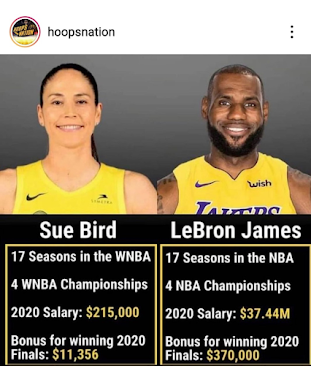Machismo? Stereotypes and assumptions — unpack these through a social construction analysis with one example from your local community, job, experience, etc.
In Western society, machismo is seen/heard every day.
In professional sports, male players are held in a high regard for their physical strength. They are paid in excess of what most people will make in a lifetime. No one needs $41 million dollars in one calendar year. This is the amount made public that LeBron James, LA Lakers, will take home in 2022. But why isn't his counterpart in the WNBA, Sue Bird of the Seattle Storm being paid the same amount? We have accepted this as the norm for years between the two leagues.
Picture: NBA Player & WNBA Player Comparison
At the start of this century, I worked for Toys R Us. At the time, business was booming and bankruptcy/going out of business was not in the forecast. Amazon did not exist and the seed for online shopping was just being planted. It was only used for major high end items that had home-delivery as its only option. As a result, each store's warehouse had the most employees compared to the other departments throughout the store. At every store, most of the employees in the warehouse were men. If you were male, regardless of your sexual orientation or identity and you worked in customer service at the front of the store, or in the boys toys or in the party/seasonal departments, at my store, you were made fun of by the men in the warehouse. Homophobic slurs in both English and Spanish. Females did not work in the warehouse. The only time that they did was when they were looking for something that was in stock but not on the shelf. They would ask one of the men to locate it on the racks and they would wait for the product at the entry door closest to their department. I was an assistant manager at the time and worked in Customer Service. Occasionally, I had to watch the entire store while the store manager took their lunch break or had to be on a conference call (pre Zoom or Skype!). I recall walking back to the warehouse on many occasions and hearing cat-calls in both English and Spanish. I reminded them every time that I had the authority to fire employees for inappropriate behavior, including continued harassment which is what it was. I was called names by some of them or received comments about needing a man, or staying at home with the kids. I never felt unsafe since the entire store had surveillance. In the warehouse, there were also co-workers who were respectful and would call out their department colleagues as well.
I am a firm believer that behavior is learned from someone or somewhere. You aren't born being homophobic or with toxic masculinity in your bones. At some point in their lives, those that chose to risk their employment at my store, heard someone use the derogatory words and phrases likely toward a woman or boy/man who was gay or who was part of the LGBTQ+ community. It was not addressed properly in front of them and therefore they accepted it.
We must engage with our families. See something, say something.
One parent should not shoulder the responsibility to raise the children if two parental figures are in the home. If children aren't in the picture, one spouse or partner should not solely take on the typical gendered roles: cooking, cleaning. Machismo mentality sets up gendered roles in the household but also in public spaces. Look in the school cafeteria's. Most of the employees there are "the Lunch Ladies". Are men applying for these jobs? Do they know that they too can serve food to children or male/female colleagues?
A machismo attitude can be seen in the workplace. An example that I am familiar with is the growing need for male teachers. It is still seen as a profession for women. I did not have a male teacher until 7th grade and from 7th grade-12th grade, I had fewer than five. Texas Public School Principals who are men were once teachers. It is widely acceptable by young boys to want to become a Principal, but when you ask them about becoming a teacher, they turn their nose.
In most clothing stores, there are boys, girls, women, men's departments. How are they separated? The colors & cut of the fabric and the print. Flowers and unicorns vs. dinosaurs and superhero prints. It is the old adage that pink is for girls and blue is for boys. What about the other genders or just gender neutral clothing?
Pic: Girls Department at Toys R Us, 2006


Comments
Post a Comment